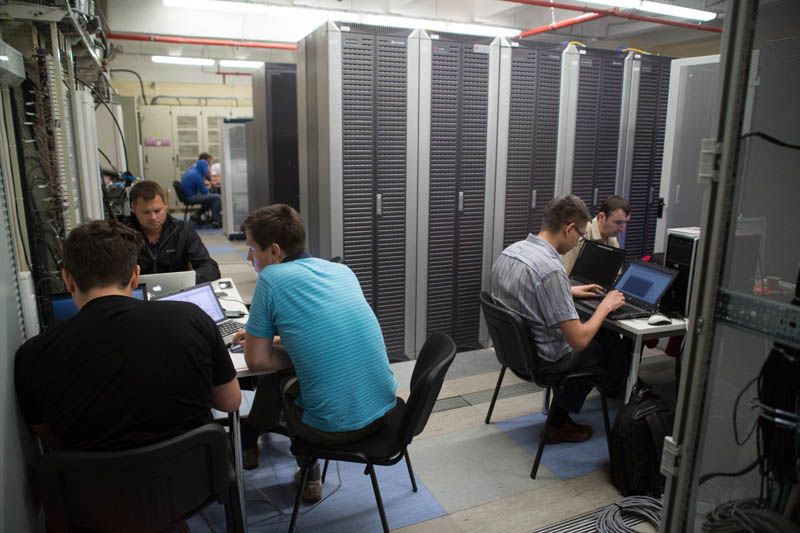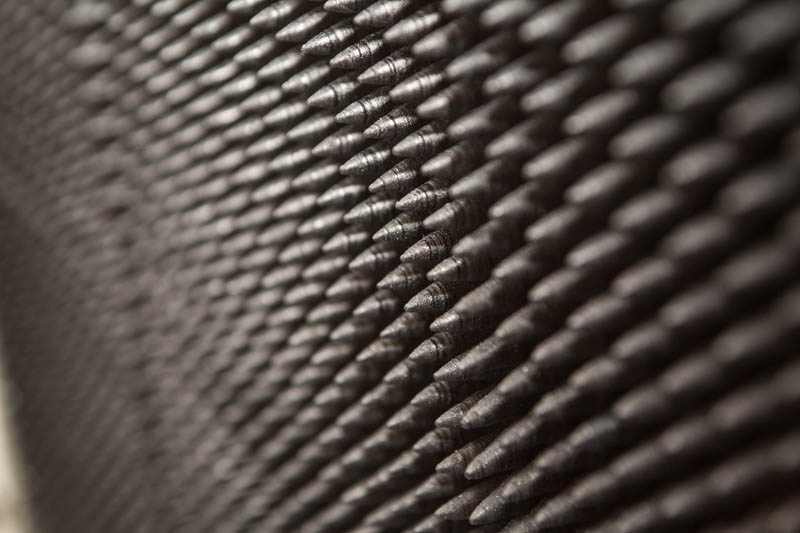"Test Zone" Beeline: go to the tight lock, dress warmer at the gym and turn off the phones

Antenna system elements: RF cable, variable attenuator (test load)
The object looks like a data center machine building , only the equipment is more variegated and the engineers working with it are in the hall for more time. From equipment works constantly from 2 to 6 groups of engineers. Passing through the main building, you can catch the warmly dressed engineers of the Huawei company, the Europeans in the classic dress code, or the experts of the Beeline company who take tests and control everything that happens.

Engineers turned right in the machine room, but much more often the work goes remotely.
')
Inside, up to 15 cellular networks of different standards and manufacturers work simultaneously. On the area of 250 square meters, there are about a hundred racks in which full-fledged segments of the backbone transport network, urban transport network, billing, packet and voice backbone network, controllers and base stations of mobile networks of different standards are implemented.
Traffic. Then a lot of photos of equipment.
When equipment manufacturers offer us their new solutions, before putting them into a live network, you need to make sure that the equipment works as we need, and conduct a large number of different tests. As a rule, we are talking about "hard" solutions of the Core Network level (each of which may consist of several racks), new base stations of different standards, equipment of the transport network, and so on. Understandably, you need a place where all this can be collected, enabled, configured and tested. In Beeline for many years, such a place is - this is the "Test Zone" TDR

The view from the height of the ladder
According to the results of the tests being performed, the optimal configuration of the hardware, the necessary software functions are selected and fine tuning of all parameters is carried out for perfect collaboration of all devices.
Despite the high rate of rotation of the equipment (entire racks may change several times during the month), the requirements for the quality of installation remain the same as on commercial sites. Otherwise, you can lose a few weeks to unsuccessful tests of advanced solutions, and the problem will be in a carelessly crimped cable. And the classical understanding that “only beautiful planes fly well” is absolutely true for our sphere - only beautifully laid cables work well!

Competent installation of cables connected to a multiport switch
The number of laid cable communications in the TK is not evaluable, only the power supply cables alone lie below the raised floor for about 12 kilometers.
The gateway at the entrance to the engineering wing, serves for additional security. The second gateway door will open only when the first one closes.

Safety requirements for engineers working on the "Test Zone" are very high, and they relate to both safety and knowledge on labor protection and electrical safety. For example, a group of Chinese engineers configuring their equipment. To get the right of access to the premises of the TZ, you must have an admission level of the 3rd group on electrical safety (for working with electrical installations with voltage up to 1000V), since it will not work for Russian citizens to receive foreign documents - they work here only when accompanied by our experts who have the necessary tolerances.

Brainstorming by Chinese engineers
Before entering, it is better to turn off mobile phones, because behind this door, there is a real tumult in the radio.

Armored door to the room TZ
More than a dozen base stations of different standards (GSM / UMTS / LTE / Wi-Fi) and different manufacturers can work in a closed room at the same time. How your phone behaves in such a complex radio environment is a big question. Often, those who have not taken care of disconnecting the phone in advance will remain confident that they are in touch, while the telephone, which has been crazed by test radio, has long been waiting for a reboot to return to its native mobile network.
To reduce the level of radiation from base stations to safe - each base is equipped with attenuators (constant or variable) - devices to reduce the intensity of the electromagnetic signal.

Antenna system elements: RF cable, constant attenuator, omnidirectional antenna - OMNI
At the same time, in order to conduct tests of a specific base station, it is required to ensure complete isolation from external factors, bringing the state close to the test telephone close to the “spherical radio signal in vacuum”. For this purpose, special shielded cabinets are used - radio frequency anechoic chambers that do not transmit EM signals. Of course, they do not miss it - it is strongly said, or rather it will be - they almost do not miss it and the less it is “almost”, the more expensive the anechoic chamber. TZ Beeline is equipped with several anechoic chambers, the shielding properties of which are sufficient for our tasks.

The inner wall of the radio frequency anechoic chamber
An anechoic chamber with panel antennas and telephones inside for testing mobile networks. The door closes, power is supplied to the base station transceiver, and we can begin testing.

Everything is ready for the beginning of the mobile network tests

Panel antennas in anechoic chamber and test mobile phone

And here you can see the rack from which the tests go. Ericsson Multistandard Base Station with RF cables, fixed and variable attenuators and an anechoic chamber.
How it all works
To ensure the smooth operation of the TZ, all conditions are created:
- Redundant power for commercial equipment, power management rack:

The color scheme may be unexpected, but, most importantly, the equipment functions:

- Automatic fire extinguishing system:

- Surveillance system - cameras monitor each row of equipment:


The equipment enters the hall through a freight elevator, and a platform is installed directly in the TZ room to raise the imported equipment to the raised floor level:

For rooms with a raised floor, one of the main tools is a vacuum sucker, usually called a “frog”:

That's how the cable is laid under the raised floor, using special cable routes and trays:

To connect the equipment in the "Test Zone" to the power supply network, it was decided to test the proposal from ABB, "The system of detachable installation of electrical equipment Smissline".

Automatic machines with installed current sensors, with the help of which in real time it is possible to control the load on each automatic device

Implementation of the Smissline system solution in a switchboard (wall hanging version)

Smissline busbar system near, easy installation, protection against electric shock, flexibility and time saving when replacing consumer machines
What is iron

Racks in even rows. Installation completed, all racks closed
In the TZ, there are practically all systems and vendors operating in Beeline: CS Core - MSC / VLR / MGW / HLR, PS Core - SGSN / GGSN / MME / ePC, GSM radio - BSC / TRC / BTS, UMTS - NodeB / RNC, LTE - eNodeB. In addition, transport network segments are emulated - MEN, IP / MPLS. Such a complete “set” of equipment allows you to collect schemes as close as possible to a commercial network, but lacking influence on the services of “live” subscribers. If any question arises related to the verification of the existing equipment - before implementing the configuration in commercial networks, the necessary settings are applied on the test equipment, and we can evaluate their impact on all the nodes with which it interacts.
Next - a small photo-excursion on some equipment that works in our TK.

Huawei multistandard base station for indoor use
One of the elements of the obsolete inheritance is the cross-panel for cross-crossing E1 flows. In the new equipment this type of transport is practically not used, all networks are transferred to the optical transport (STM) or to the Ethernet FE / GE / 10GE channels.

Copper cross (DDF 120 Om) with KRONE plinths. Mainly used to provide GSM base station transport

A router that implements a test segment of the transport network of base stations. Do not sign the cable here is fatal

Ericsson BSC network controller manufactured by Ericsson, model evoBSC8200 (the newest model from the Swedish manufacturer)

Voice Switch Huawei MSoftx3000

Cisco ASR5000 chassis, on which test Packet Core is built for GSM / UMTS / LTE network segments

Telecom-equipment internal IP Backbone test Packet Core based on Cisco


Huawei OSTA 2.0 test chassis boards. The chassis of the Huawei OSTA 2.0, on which the test IMS Core is built.

Racks with Comverse equipment, which implements a test segment of the billing system


Interior panels (optical and Ethernet) in a rack with MGW equipment from Nokia

ZTE Compact LTE Compact Base Station

Radio transmitters (RRU) of various standards (2G / 3G / 4G) and various manufacturers

Ericsson Multistandard Base Station for indoor use

Ericsson pico base station GSM production
One of the most important tasks of the TOR is to check the functionality of the new equipment. For example, with the advent of commercial LTE networks, there were enthusiastic and knowledgeable people in Russia who were able to start production of low-power LTE standard base stations (http://ranberry.net/ru).
Beeline, together with Russian developers, conducts full-featured testing of pico eNodeB LTE, testing all aspects - from the ease and reliability of integrating a base station into an existing mobile network, to checking the mobility procedures between the new base and the existing ones.

The inscription "Made in Russia" - an extremely rare phenomenon on such devices

Combined Wi-Fi + Femto 3G module from Cisco.
Look closely at him, now in the telecom there has been a development of the direction of miniature multi-standard devices, and perhaps very soon such solutions can be purchased for personal use in an ordinary electronics store. Now the tests continue and pass very successfully.

MetroEthernet test network segment - Alcatel-Lucent 7750 SR-7 router

The transport network segment, for connecting multi-standard base stations, on Alcatel-Lucent and Cisco equipment.

Huawei Rack Module KVM
Such modules can often be seen in telecommunications racks, they are used to organize local access to equipment.

Ericsson UMTS Standard Transmitter

Packet Balancer
And finally - a couple of exhibits that you can hardly find in the usual data centers, or machine rooms of the telecom operator:
The first exhibit:

It seems that he looks like an old radiographer, which once stood at my grandmother's, and even brings up “warm-tube” associations.
In fact, it is the newest UMTS radio network controller - RNC, from the NSN company. In our TZ was installed, integrated and successfully passed the tests, the first sample of this type of equipment in Russia.

Second exhibit:
It looks like a strange multiport server, also locked with a combination lock.

This is one of the key elements for carrying out tests of the transport network - the Spirent Test Center, which allows you to create in the packet networks almost everything that you can think of to implement the most tricky test scenarios. In the current configuration, the test center has 8x10GE and 4xGE ports and allows you to generate various types of L2 / L3 traffic (both unicast and multicast / broadcasts); emulate tens of thousands of client devices and routers with full support for all major network protocols, such as routing protocols (OSPF, BGP, IS-IS); basic service protocols (ARP, DHCP); MPLS; synchronization (PTPv2, SyncE). This set allows you to conduct a full set of functional and load tests of the transport network equipment.
According to the "Test Zone" we were taken:

Polyak Yevgeny Olegovich,
the permanent head of the "Test Zone" since its inception

Glebov Victor G.,
leading expert of the mobile core network development service
Links
Source: https://habr.com/ru/post/229861/
All Articles